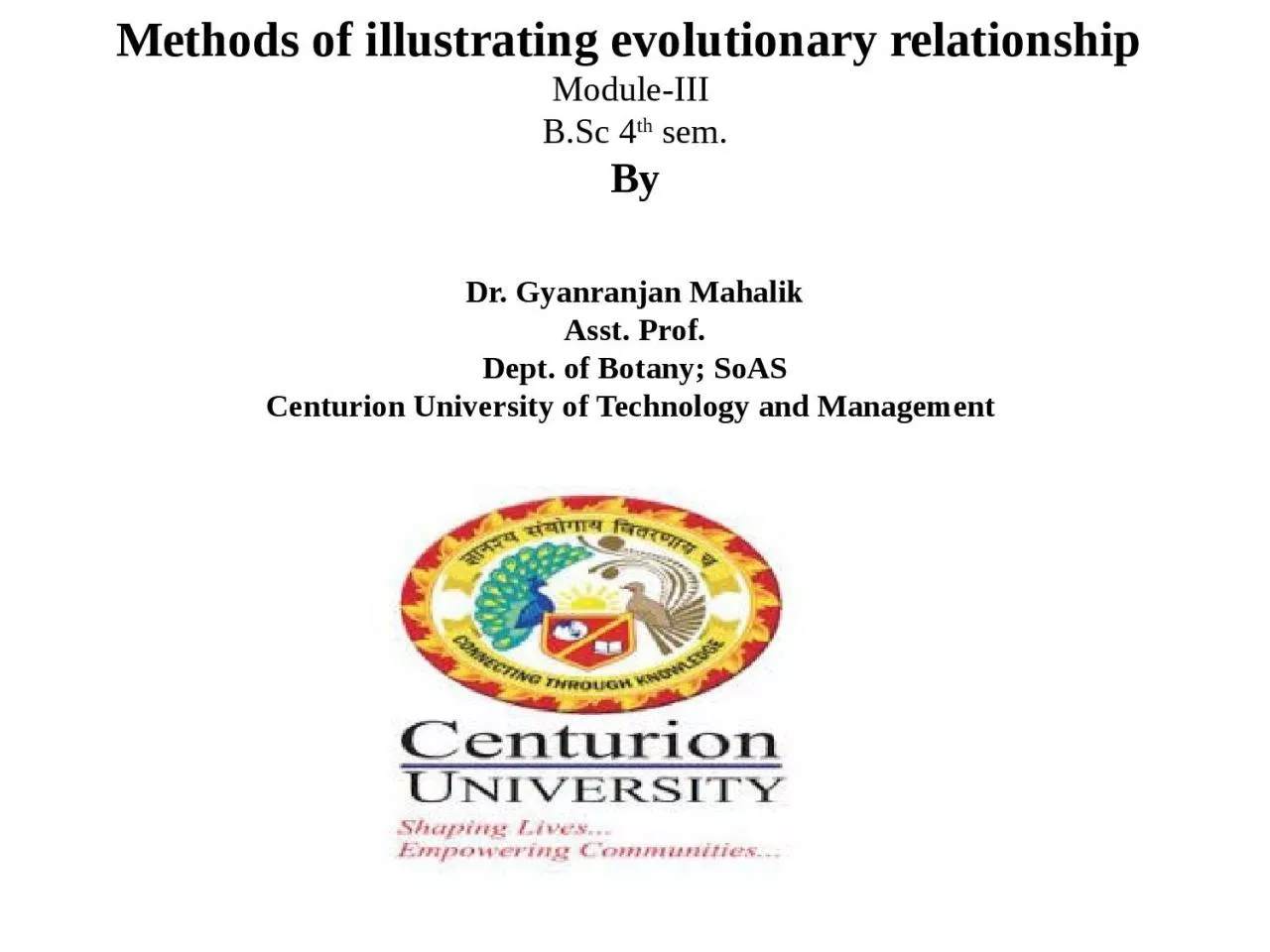

ModuleIII BSc 4 th sem By Dr Gyanranjan Mahalik Asst Prof Dept of Botany SoAS Centurion University of Technology and Management Systematics is the part of science that deals with grouping organisms and determining how they are related It can be divided into two ID: 1025140
Download Presentation The PPT/PDF document "Methods of illustrating evolutionary rel..." is the property of its rightful owner. Permission is granted to download and print the materials on this web site for personal, non-commercial use only, and to display it on your personal computer provided you do not modify the materials and that you retain all copyright notices contained in the materials. By downloading content from our website, you accept the terms of this agreement.
1. Methods of illustrating evolutionary relationship Module-III B.Sc 4th sem.ByDr. Gyanranjan MahalikAsst. Prof. Dept. of Botany; SoAS Centurion University of Technology and Management
2. Systematics is the part of science that deals with grouping organisms and determining how they are related. It can be divided into two main branchesi. Taxonomy focuses on classifying, naming, and grouping organisms. A group, or taxon, can be a population, a species, a genus, or a higher-level grouping, such as family, order, class, phylum, kingdom, or domain. The plural of taxon is taxa.ii. Phylogenetics is the study of determining evolutionary relationships, or patterns of descent of organisms.Evolutionary TreeAn evolutionary tree can also be called a phylogenetic tree, or a just a phylogeny. There are many different ways to draw phylogenies, but they do all have certain parts that you must understand before you try to interpret them.The root of a phylogeny represents the common ancestor of all the descendants in the tree. The descendant taxa are labeled at the tips of the tree. A node splits into two branches and indicates a divergence or speciation event. The node itself represents the common ancestor of any descendants that branch off of it. The two taxa that branch off at a node are called sister taxa.
3. They share an immediate common ancestor. In this phylogeny, taxa B and C are sister taxa. They are both equally related to taxon A.The branches of a phylogeny can be rotated around a node without changing evolutionary relationships. If you want to determine how two or more taxa are related, it is important to look at the nodes and branches in a tree and not just the ordering of descendant taxa. Sometimes the evolutionary relationships between taxa cannot be determined. This results in a phylogeny with a polytomy, or a node from which more than two groups split.A clade is a group that includes an ancestor and all of its descendants. Clades, also called monophyletic groups, can be nested in larger clades. For example, mammals are a monophyletic group because they all descended from a common ancestor. Within the mammals, there are also many smaller clades, such as primates or bats.Not all groupings of organisms qualify as monophyletic. A paraphyletic group consists of an ancestor and only some of its descendants. Reptiles are animals like crocodiles, lizards, and snakes. This is actually a paraphyletic grouping because the ancestor that gave rise to all reptiles also gave rise to birds. If birds are added to the definition of reptiles, then it could be considered a monophyletic group.
4. A polyphyletic group is made up of various descendants with no recent common ancestor. Marine mammals are polyphyletic. Whales and seals are both marine mammals, but they are not closely related at all. Seals are more closely related to bears than they are to whales. Whales share a more recent common ancestor with deer than they do to seals.
5. Cladograms and Phylogenetic TreesBiologists use cladograms and phylogenetic trees to illustrate relationships among organisms and evolutionary relationships for organisms with a shared common ancestor.Both cladograms and phylogenetic trees show relationships among organisms, how alike, or similar, they might be. We can see a typical cladogram and phylogenetic tree here.First, a cladogram can look at trees that may have been derived from a common ancestor to arrange organisms on different branches. But those branches used aren't representative of the relative amount of change or evolutionary time that has occurred between organisms. Plus, a cladogram doesn't necessarily show exact relationships between ancestors and descendants.On the other hand, the branches on a phylogenetic tree can be proportional to the amount of change or evolutionary time. So, you can also track how species have changed over time. Species are still grouped according to similarities and physical or genetic characteristics - for example, the presence or absence of gills. But, a phylogenetic tree describes an evolutionary history by showing how ancestors are related to their descendants and how much those descendants have changed over time.
6. Fig. Phylogenetic Fig. Cladograms